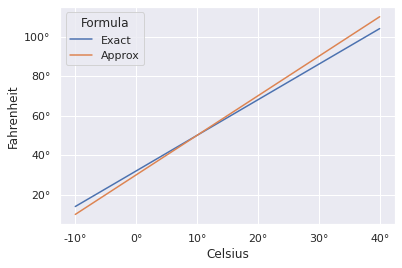How to Convert from Celsius to Fahrenheit in your Head
The Simplified Formula
As an American who frequently travels abroad and has a European partner, I’m often faced with the problem of needing to convert temperatures from Celsius to Fahrenheit. The exact formula is a bit too complicated to do in your head, but thankfully there’s a simplified version that gives extremely accurate results. Given a temperature in Celsius you simply:
- Multiply by 2
- Add 30
That’s it, that’s the whole thing. (You can also go from °F→°C by inverting the steps: first subtract 30, then divide by 2.)
To show how accurate it is, see the graph below showing the exact formula alongside this approximate formula.

For temperatures within typical day-to-day ranges, the two differ by only a few degrees. In particular:
- Between 5°C and 15°C, the results differ by less than 1°F
- Between 0°C and 20°C, the results differ by less than 2°F
- Between -5°C and 25°C, the results differ by less than 3°F
- Between -10°C and 30°C, the results differ by less than 4°F
Why It Works
The exact formula for converting from Celsius to Fahrenheit as it’s taught in school is:

The reason why this is hard to use directly is twofold:
- It’s awkward to mentally multiply 9/5
- It’s awkward to mentally add 32
So to simplify things we replace each of these values with the nearest nice round number:
- 9/5 (=1.8) → 2
- 32 → 30
Because the first approximated constant is an overestimate (2 > 9/5), and the second is an underestimate (30 < 32), the two effects roughly cancel each other out.
In particular, they perfectly cancel each other out when the magnitude of the overestimate (2–9/5 = 1/5x) exactly matches the magnitude of the underestimate (32–30 = 2), which happens at 10°C since 1/5 x 10 = 2. This is why the lines in the above graph cross at 10°C.
Wrap-up
I’ve used this trick to mentally convert temperatures more times than I can count. In fact I’ve used it so much that I’ve started adding correction factors for the cases where it significantly over or underestimates. Given how often I’ve come to rely on it, I’m sure you all can get some usefulness out of it too.
